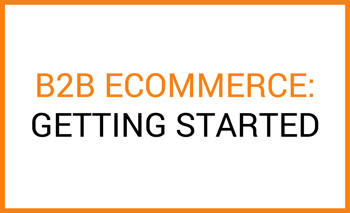Getting Started with B2B eCommerce
 How to plan your B2B eCommerce Project
How to plan your B2B eCommerce Project
According to an infographic from Digital Commerce 360, the B2B eCommerce market is on track to reach $1.1 trillion by 2021. But, as of today, less than 50% of B2B companies have an eCommerce site. If your organization is in the majority of B2B companies without a B2B eCommerce site, you need to start thinking about it. Of the B2B organizations that don’t have an eCommerce site today, 70% are projected to have one within two years. If you haven’t started planning your B2B site, you will soon be left in the dust.
Why eCommerce for B2B?
We’ll admit that eCommerce can be a hard sell for some B2B organizations. But an eCommerce site can be a great tool to help your sales staff and customer service team do their jobs better. And, simply put, eCommerce can help grow your business.
Consumer Executive Board (CEB) estimates that buyers are 57% of the way through the buying process before they have their first direct contact with a seller. Your potential customers are already looking for you, so you need to give them something to find.
Providing customers with the ability to purchase products and services via a website creates a convenient sales channel for your customers and encourages ongoing customer interaction. B2B companies who are not taking advantage of eCommerce are going to leave dollars on the table.
Additionally, think of the calls that your customer service center gets most often. Regardless of your industry or offering, many of those questions are probably along the lines of:
- Do you have this item in stock?
- What is my price?
- Where is my order?
If your eCommerce site is capable of answering those three questions for your customers, you are off to a great start.
How to kickstart your B2B commerce site
It’s important to set the groundwork for a B2B eCommerce site so that your site is able to grow with your business and serve you well for years to come. Here are our tips for getting started.
Define the Strategy
It’s important to ask a few key questions up front:
First, what is the site intended to do? Is it intended primarily to increase revenue, decrease costs, or improve customer satisfaction? These should be ranked in order of importance, with only one of these ranked as number one.
Does it align with the company mission and vision statements? Without that alignment, the project will not receive the support of the executive team, or anybody else for that matter.
Can you measure the success? A B2B eCommerce site needs to have clearly defined measurements of success. This allows the project team to have explicit targets, allowing them to evaluate options and make decisions along the way.
Prior proper planning allows everyone within the company to understand the scope of the project, when each milestone will be completed, and most importantly why the project is being done in the first place. This sets a foundation and creates alignment within the company, so that everybody is working towards a common goal.
Engage the Sales Team
Often the sales team, particularly in a B2B environment, sees the new eCommerce site both as competition as well as a ‘toy’ that the IT department is playing with. Of course, neither is correct, and both views can be contagious within the organization. Given this, the project team must engage the sales team early and often to rally their support for the new site. Typically, once the sales team understands how the site aligns with the corporate goals, and how the site can specifically help them, they will embrace the project and the new site.
Crown Your Champion
B2B eCommerce projects touch almost every part of the organization: sales and marketing, operations, finance, and especially IT. There must be a champion for the B2B site; naming an eCommerce director will help to drive the project through to launch. Also, this key leader will ensure that the site is nurtured and continues to grow once it has been launched.
Pick Your Technology
One key part of your B2B eCommerce project will be picking the right tool for the job. You shouldn’t use an ill-fitting platform for your B2B eCommerce site.
We’ll admit that we’re biased when it comes to platform choice. After years in this industry, we’ve worked with enough bad options to know the good ones when we see them. But, ultimately, it’s the client’s decision and we can only help you make the most educated choice that you can.
Why Magento for your B2B commerce solution?
Using a Platform as a Service or On Premise option is our top recommendation when it comes to launching a B2B eCommerce site. This option gives you the most flexibility and opportunities to integrate with services and tools, allowing you to have a site with everything you need and nothing you don’t.
Our platform of choice for B2B Commerce sites is Magento, which not only gives you access to an entire community of developers and third-party extensions, but provides triple redundancy, meaning your site won’t go down. That security is a lifesaver in an industry where downtime can cost your business significant money.
Plus, Magento has been singled out as a leader in the B2B eCommerce sphere by Forrester.
What’s Next?
With those decisions made, you’re well on your way to a successful B2B eCommerce site. To move forward, you’ll need an experienced partner to help guide the way. That’s where our Magento team comes in. We have years of experience implementing and improving B2B eCommerce sites for our clients.
Ready to get started? Contact us and let’s get to work.

